Study on the Influence of Foundation Pit Excavation on the Deformation of Adjacent Subway Tunnel in the Affected Area of Fault Zones
Abstract
:1. Introduction
2. Engineering Summary
3. Tunnel Deformation Calculation
3.1. Calculation of Additional Stress in Tunnel
3.2. Tunnel Deformation Calculation
3.3. Centrifugal Experiment Verification
4. Numerical Simulation Analysis
4.1. Three-Dimensional Model Establishment
4.2. Boundary Conditions
4.3. Analysis of Numerical Simulation Results
5. Geological Parameter Impact Analysis
5.1. Impact of Elastic Modulus
5.2. Impact of Internal Friction Angle
5.3. Impact of Cohesion
5.4. Sensitivity Analysis
5.4.1. Theoretical Analysis Method
5.4.2. Analysis of Theoretical Results
6. Comparative Analysis of Numerical, Theoretical, and On-Site Measurement Results
6.1. Layout of Measurement Points
6.2. Comparative Analysis of Results
7. Prediction Formula for Tunnel Deformation Considering Structural Space Dimensions and Composite Strata Conditions
7.1. Existing Prediction Formulas
7.2. The Proposed Prediction Formula in This Paper
8. Conclusions
- (1)
- By considering the collaborative deformation effect between piles and excavation sidewall soil under the space effect of excavation, a deformation calculation formula for tunnels has been established.
- (2)
- The theoretical, numerical, and field results curves are in good agreement. Measures such as “partition excavation, avoiding peripheral loading, increasing isolation piles, and optimizing construction deployment” should be strictly implemented in the construction of foundation pits to reduce the impact on the deformation of adjacent tunnels.
- (3)
- As the geological parameters increase, the maximum horizontal and vertical displacements of the tunnel exhibit a non-linear decreasing trend, with the rate of decrease continuously increasing. Through sensitivity analysis of the influence of geological parameter variations on the maximum tunnel displacement, it is determined that the elastic modulus is the most sensitive factor, followed by the internal friction angle, with cohesive force having the least impact.
- (4)
- The fitting of data reveals a good non-linear relationship between the maximum tunnel displacement under composite strata in the fault zone and the parameter (bH/L). Additionally, a prediction formula for the maximum deformation of adjacent tunnels under excavation in this region has been derived.
Author Contributions
Funding
Institutional Review Board Statement
Informed Consent Statement
Data Availability Statement
Conflicts of Interest
References
- Zhao, X.; Wang, H.X.; Li, Z.W.; Dai, G.L.; Yin, Z.W.; Cao, S.N.; Zhou, J. Numerical Study on the Deformation of Tunnels by Excavation of Foundation Pit Adjacent to the Subway. J. Appl. Sci. 2022, 12, 4752. [Google Scholar] [CrossRef]
- Zhou, J.M.; Fan, J.; Zhou, S.B. Study on soil displacement field induced by foundation pit excavation based on shape coefficient. Chin. J. Undergr. Space Eng. 2021, 17, 814–820. [Google Scholar]
- Weng, C.X.; Liu, D.S. Influence of foundation pit construction on safety of close subway tunnel. J. Shandong Agric. Univ. 2020, 51, 110–113. [Google Scholar]
- Wei, Z.F.; Hu, J.; Xu, T. Integrated Monitoring and Control of Deformation of Metro under Construction effected by the Construction of Foundation Pit. IOP Conf. Ser. Earth Environ. Sci. 2020, 580, 012044. [Google Scholar] [CrossRef]
- Zhang, Q.; Wang, Y.F.; Li, J.C.; Zhang, B.; Xu, J. Safety evaluation method of deep foundation pit adjacent to subway tunnel. China Saf. Sci. J. 2021, 31, 95–104. [Google Scholar]
- Peng, T.; Peng, Q.S.; Deng, B.; Miao, Y. Investigation and evaluation on construction risk of deep foundation pit near subway line. J. Civ. Eng. Manag. 2020, 37, 113–117. [Google Scholar]
- Mu, L.; Lin, J.; Kang, X.; Gu, Z.; Li, S. Intelligent prediction of adjacent tunnel deformation induced by foundation pit excavation based on process response. J. Build. Sci. 2020, 36, 227–232. [Google Scholar]
- Moghal, A.A.B.; Abbas, M.F.; Al-Mahbashi, A.M.; Shaker, A.A. Effect of structure anisotropy and compaction method on the swelling behavior of Al-Qatif soil. GEOMATE J. 2016, 11, 2600–2605. [Google Scholar]
- Liu, B.; Fan, X.H.; Wang, Y.Y.; Zhang, J.B.; Fan, Z.B. Research progress of influence of foundation pit excavation on adjacent existing subway tunnel. Chin. J. Geotech. Eng. 2021, 43, 253–258. [Google Scholar]
- Ding, Z.; Zhang, X.; Liang, F.Y.; Cheng, D.J.; Wang, L.Q. Research and prospect on the influence of soft soil excavation on adjacent existing tunnels. China J. Highw. Transp. 2021, 34, 50–70. [Google Scholar]
- Dong, X.; Mei, L.; Yang, S.; He, L. Deformation Response Research of the Existing Subway Tunnel Impacted by Adjacent Foundation Pit Excavation. Adv. Mater. Sci. Eng. 2021, 2021, 5121084. [Google Scholar] [CrossRef]
- Yu, Z.T.; Wang, H.Y.; Wang, W.; Ling, D.S.; Zhang, X.D.; Wang, C.; Qu, Y.H. Experimental and numerical investigation on the effects of foundation pit excavation on adjacent tunnels in soft soil. Math. Probl. Eng. 2021, 2021, 5587857. [Google Scholar] [CrossRef]
- Zhang, X.; Wei, G.; Jiang, C. The study for longitudinal deformation of adjacent shield tunnel due to foundation pit excavation with consideration of the retaining structure deformation. Symmetry 2020, 12, 2103. [Google Scholar] [CrossRef]
- Bian, X.; Hu, H.; Zhao, C.; Ye, J.N.; Chen, Y.M. Protective effect of partition excavations of a large-deep foundation pit on adjacent tunnels in soft soils: A case study. Bull. Eng. Geol. Environ. 2021, 80, 5693–5707. [Google Scholar] [CrossRef]
- Zhang, J.; Xie, R.; Zhang, H. Mechanical response analysis of the buried pipeline due to adjacent foundation pit excavation. Tunn. Undergr. Space Technol. 2018, 78, 135–145. [Google Scholar] [CrossRef]
- Chen, R.P.; Liu, S.L.; Meng, F.Y.; Ye, J.N.; Zhu, B. Centrifugal model test study on the influence of foundation pit excavation in soft clay stratum on side tunnel. Chin. J. Rock Soil Eng. 2020, 42, 1132–1138. [Google Scholar]
- Wang, P.; Ren, J.; Zhai, J.Q. Research on displacement control measures of lateral excavation tunnel in soft soil area of Shanghai. Chin. J. Undergr. Space Eng. 2022, 18, 466–471. [Google Scholar]
- Jiang, Z.H.; Zhang, Y.X. Calculation method of influence of foundation pit excavation on longitudinal displacement of adjacent tunnel. Civ. Archit. Environ. Eng. 2013, 35, 7–11+39. [Google Scholar]
- Zheng, G.; Wang, Q.; Deng, X.; Du, Y.M. Comparative analysis of deformation modes of different envelope structures on existing tunnel outside pit. Chin. J. Geotech. Eng. 2015, 37, 1181–1194. [Google Scholar]
- Cai, Y.; Xing, Y.; Hu, D. Review of sensitivity analysis. J. Beijing Norm. Univ. 2008, 1, 9–16. [Google Scholar]
- Wei, G.; Zhao, C.L.; Cai, L.L. Research on the influence mechanism of foundation pit excavation on adjacent existing shield tunnel. Munic. Technol. 2013, 31, 141–146. [Google Scholar]
- Wei, G.; Li, J.; Xuan, H.L.; Dong, L.Z.; Xu, Y.Y.; Zhang, S.M. Effect of large deep foundation pit Excavation on Shield tunnel of adjacent Metro. J. Railw. Sci. Eng. 2018, 15, 718–726. [Google Scholar]
- Liu, B.; Zhang, D.W.; Li, J.C. Prediction formula of lateral adjacent tunnel deformation caused by foundation pit excavation based on multi-case statistics and its engineering application. Rock Soil Mech. 2022, 43, 501–512. [Google Scholar]

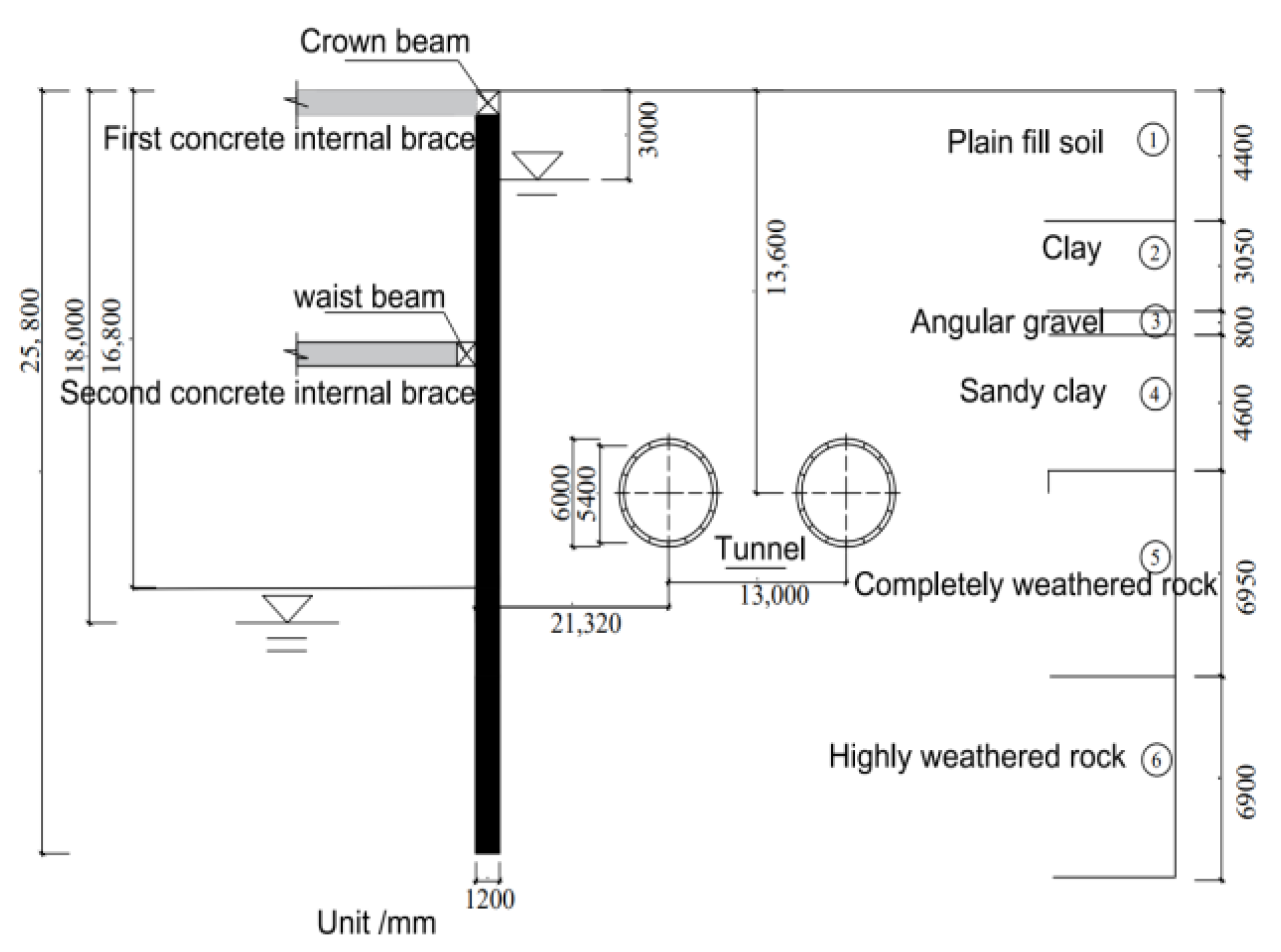
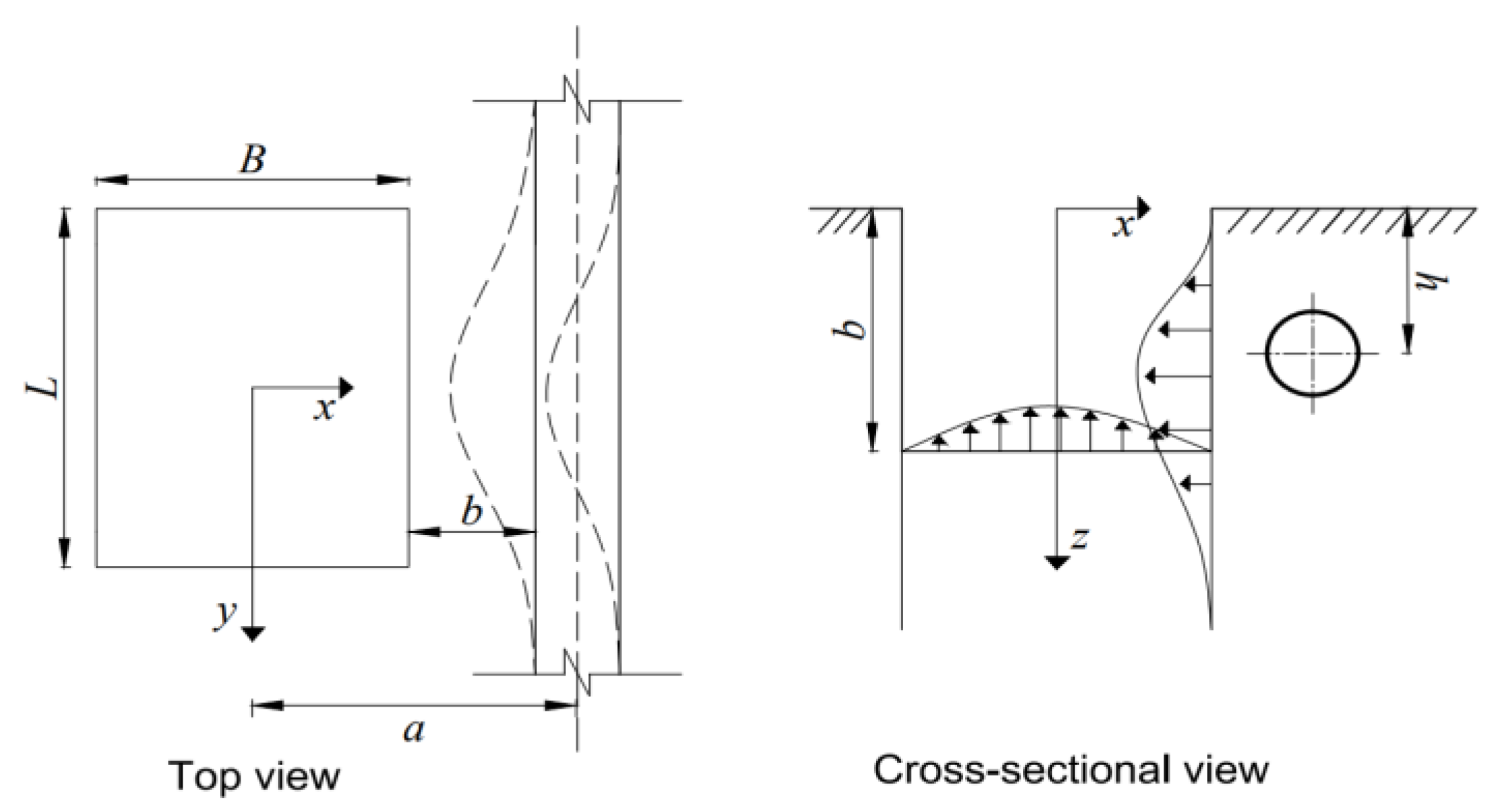
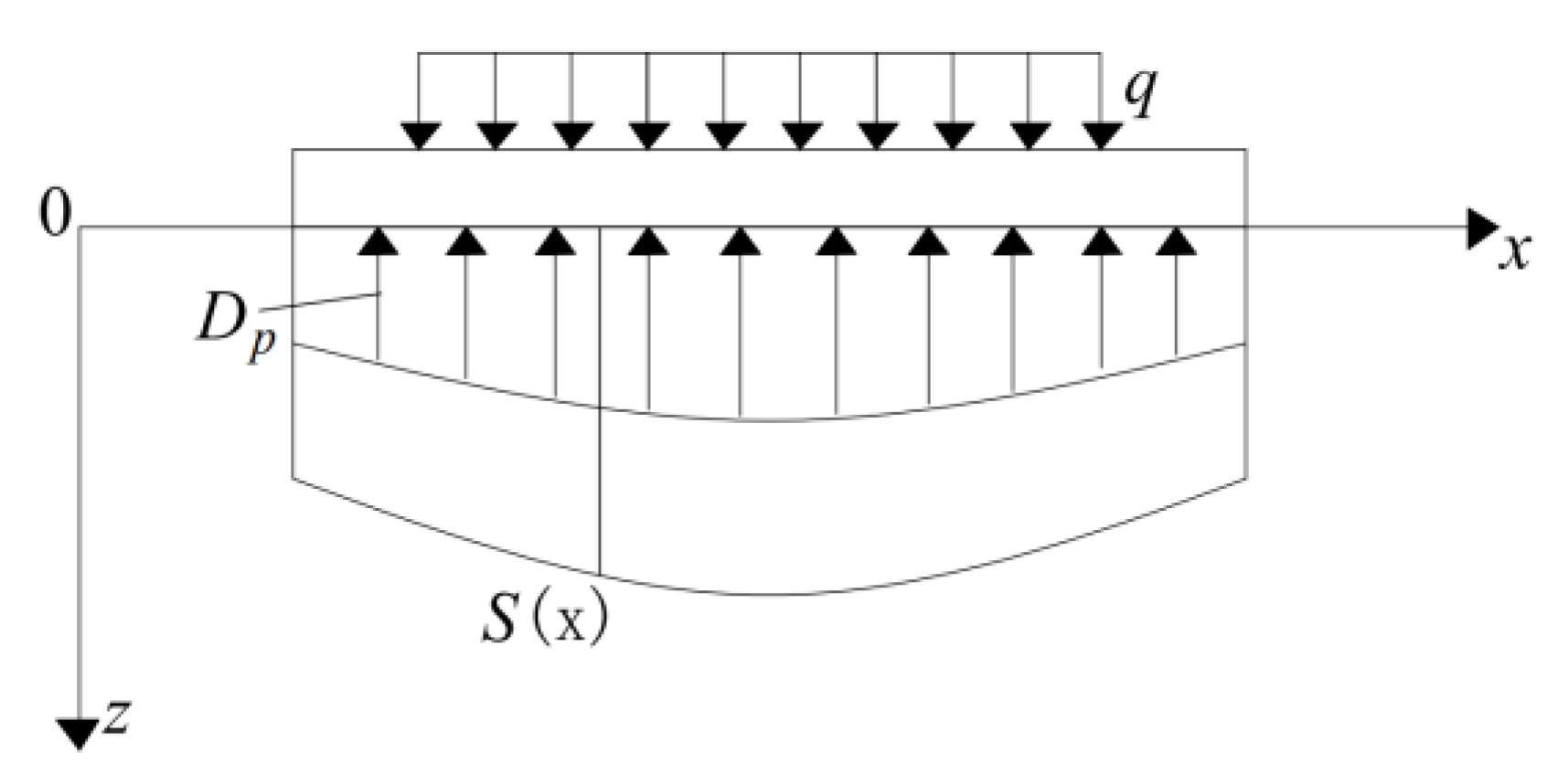
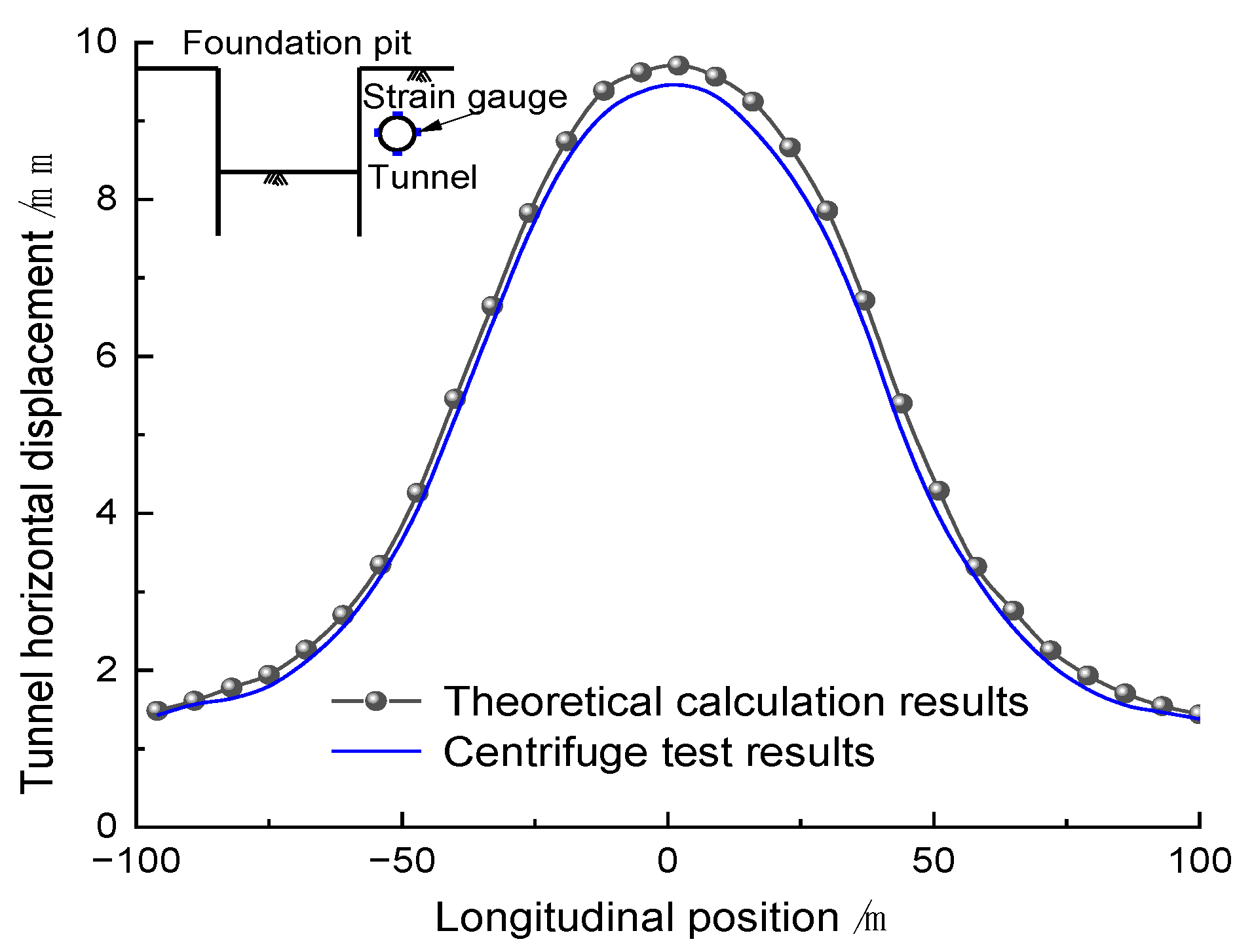
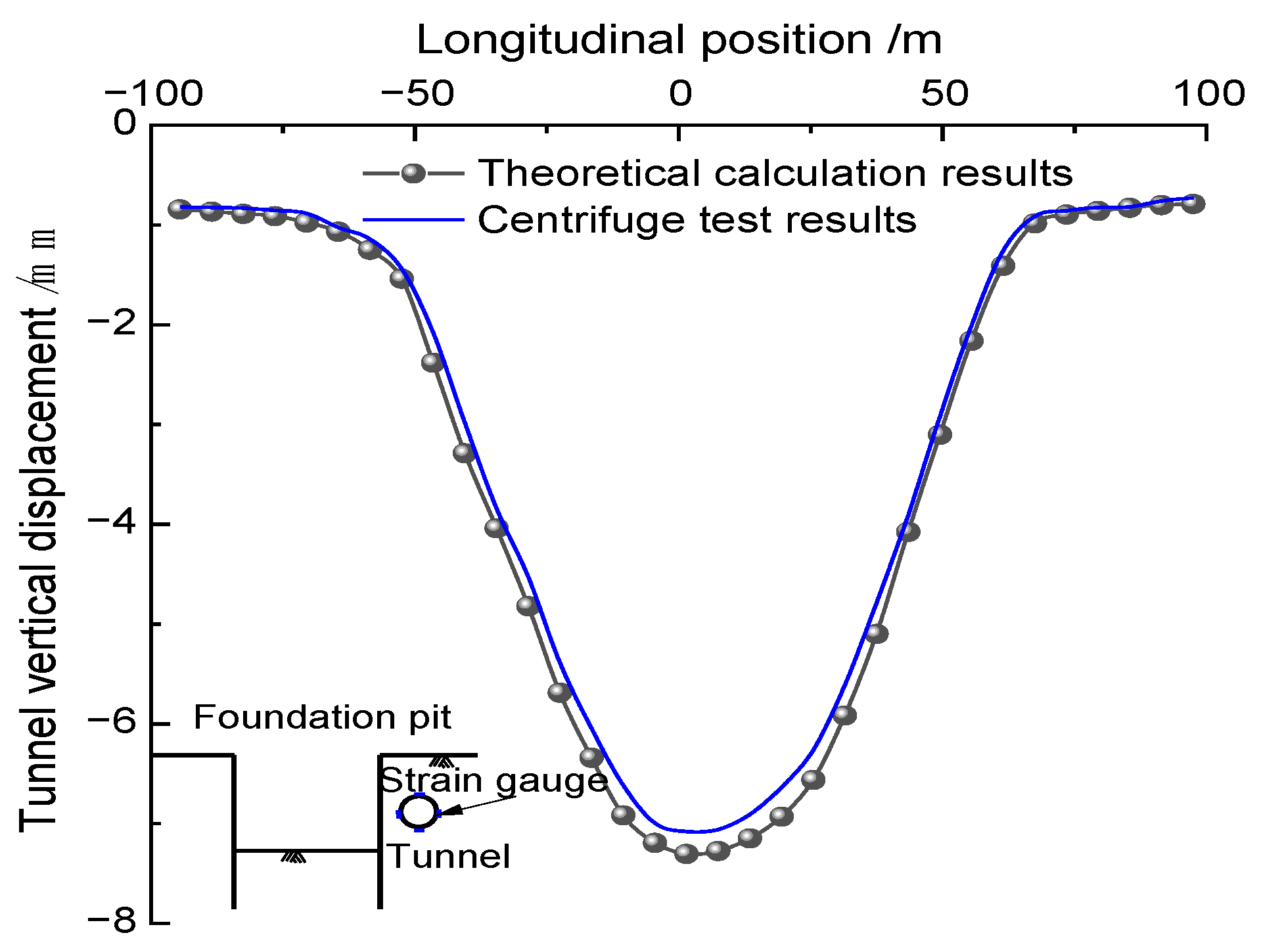
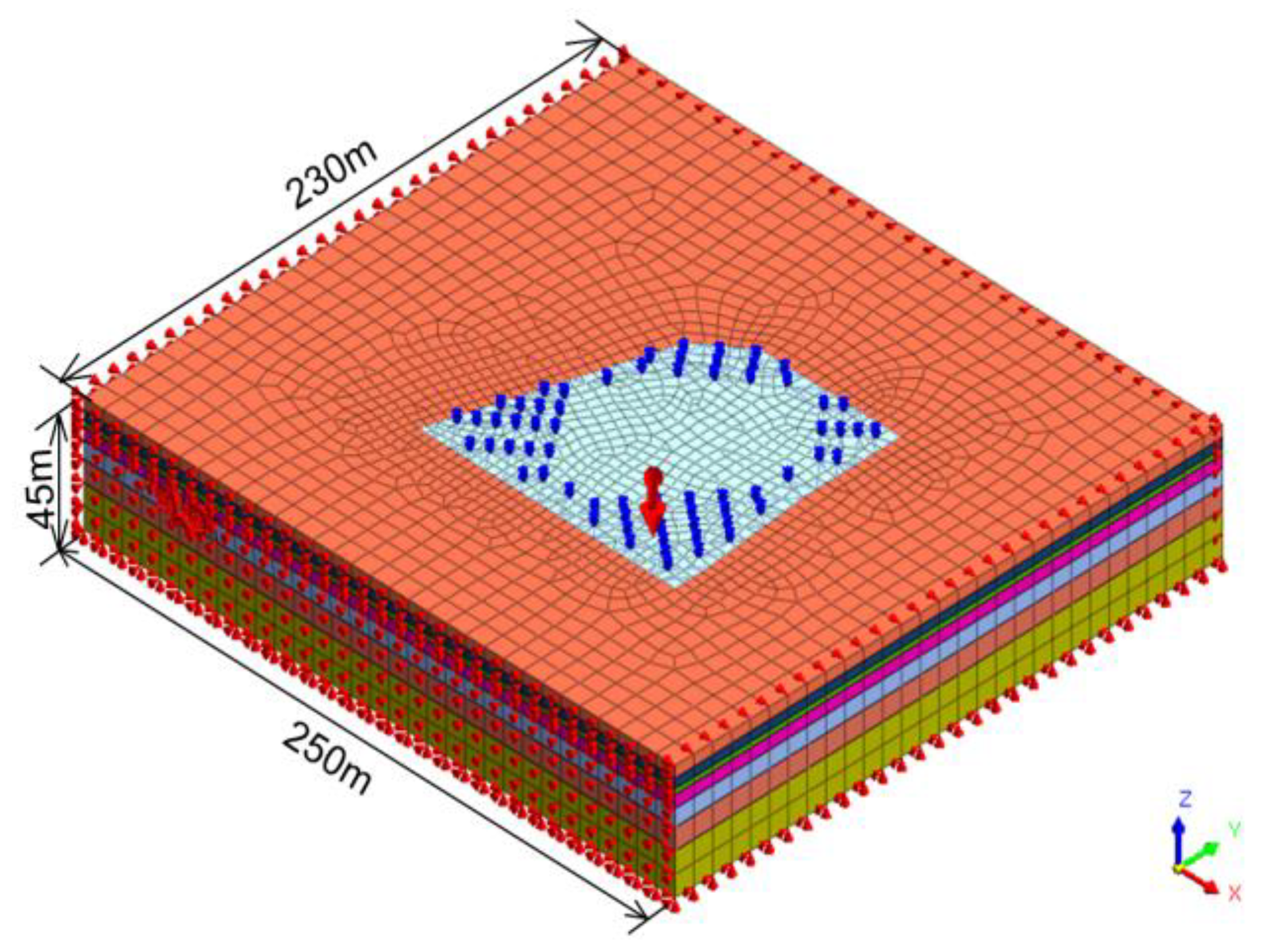

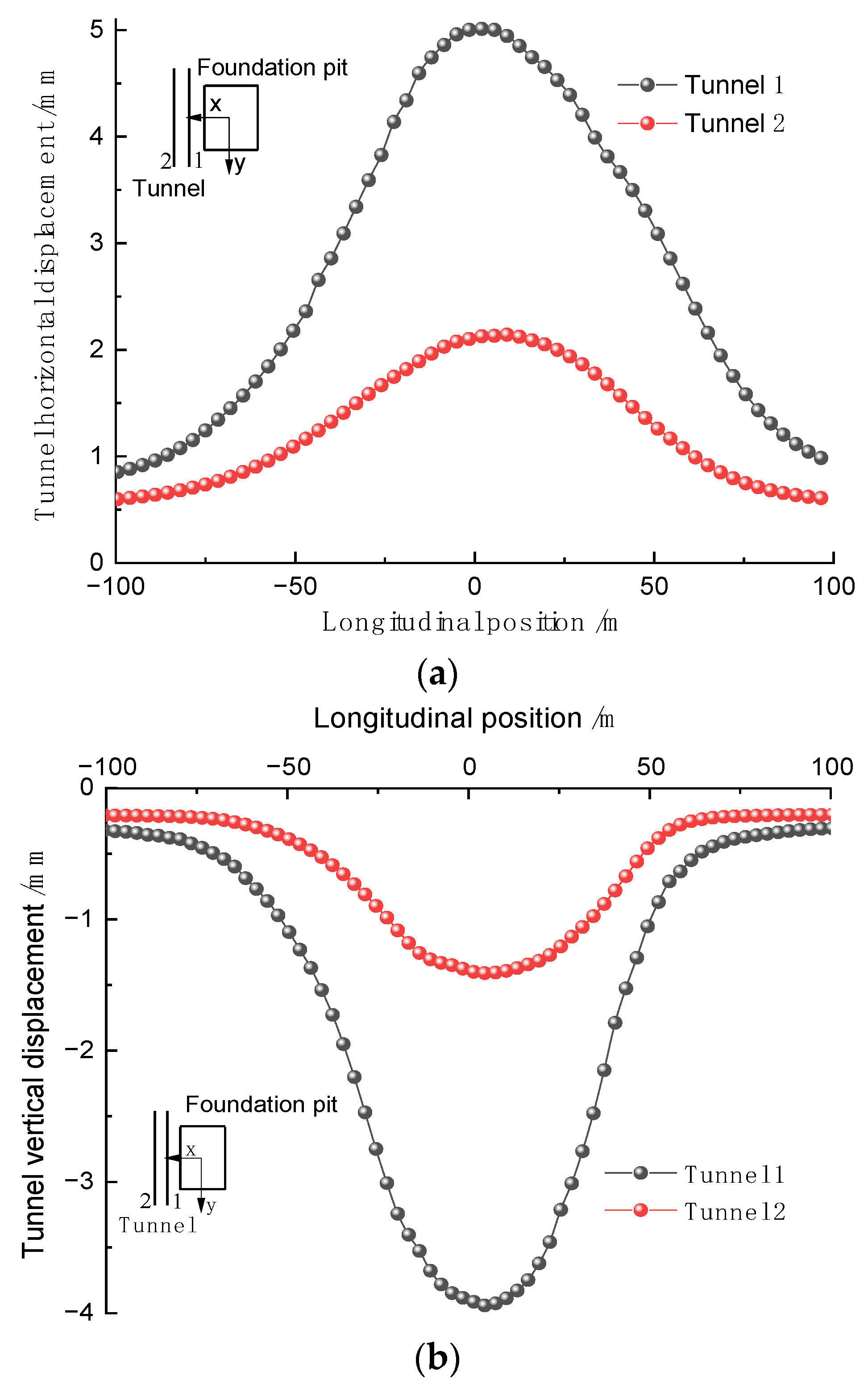
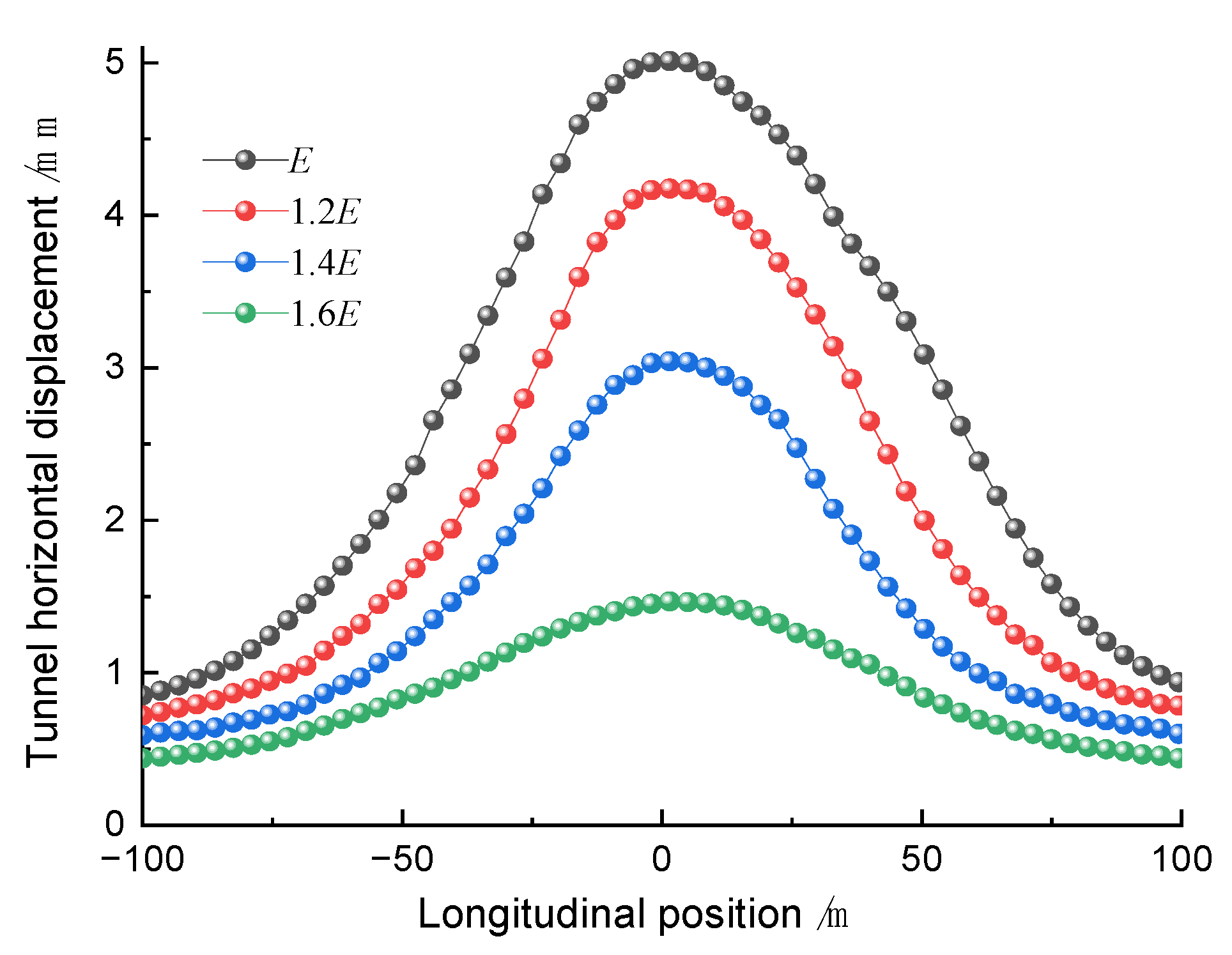
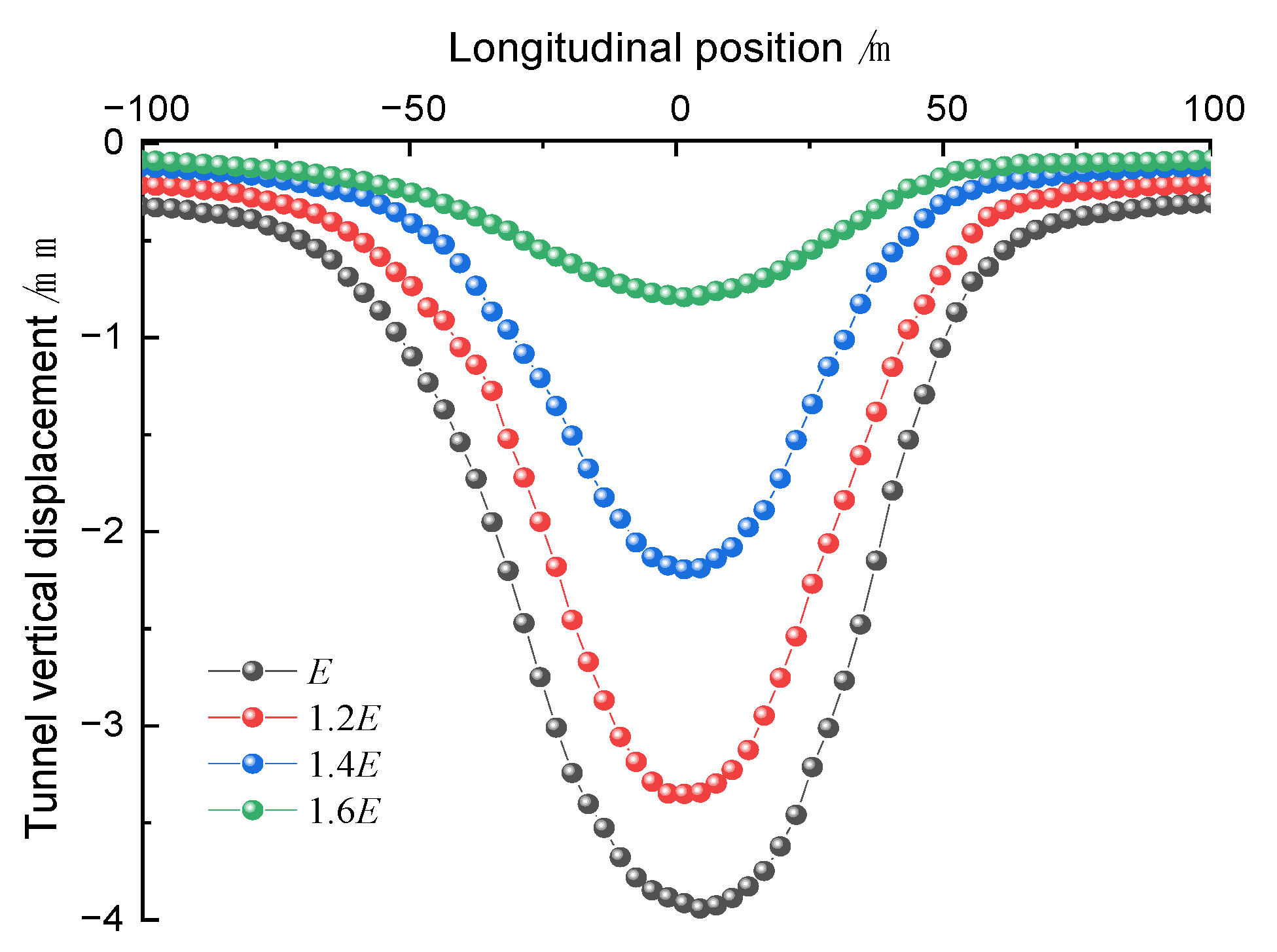
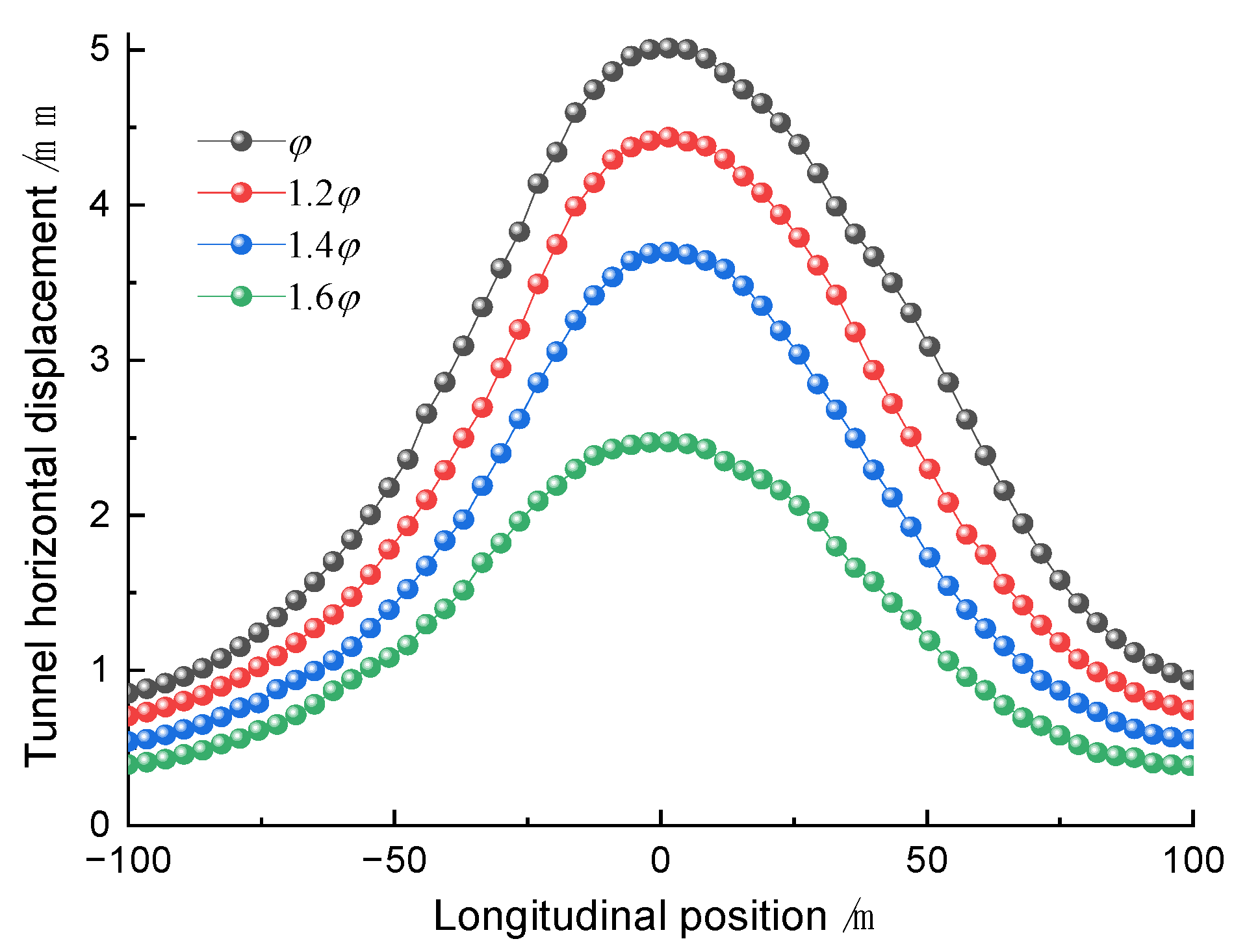
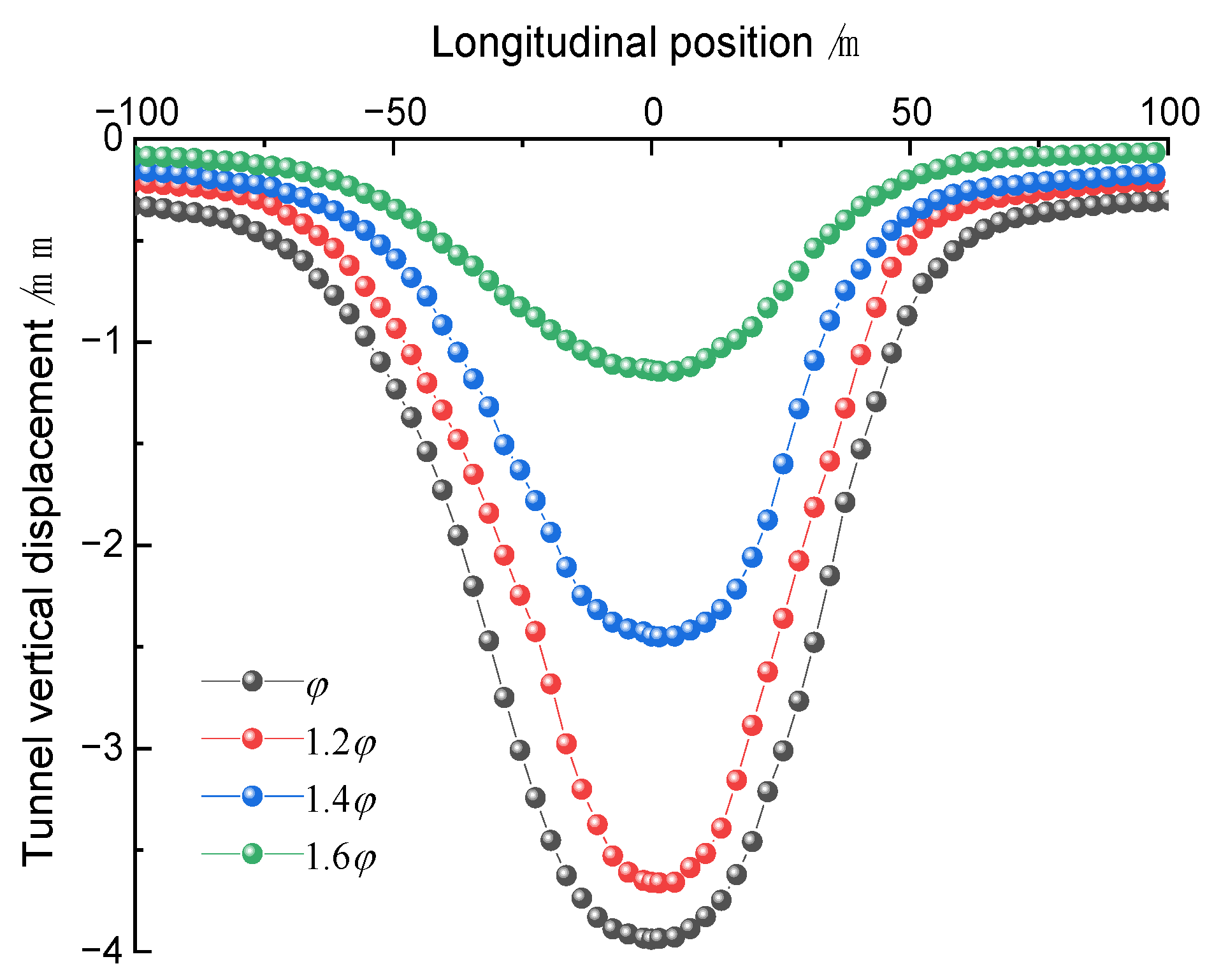
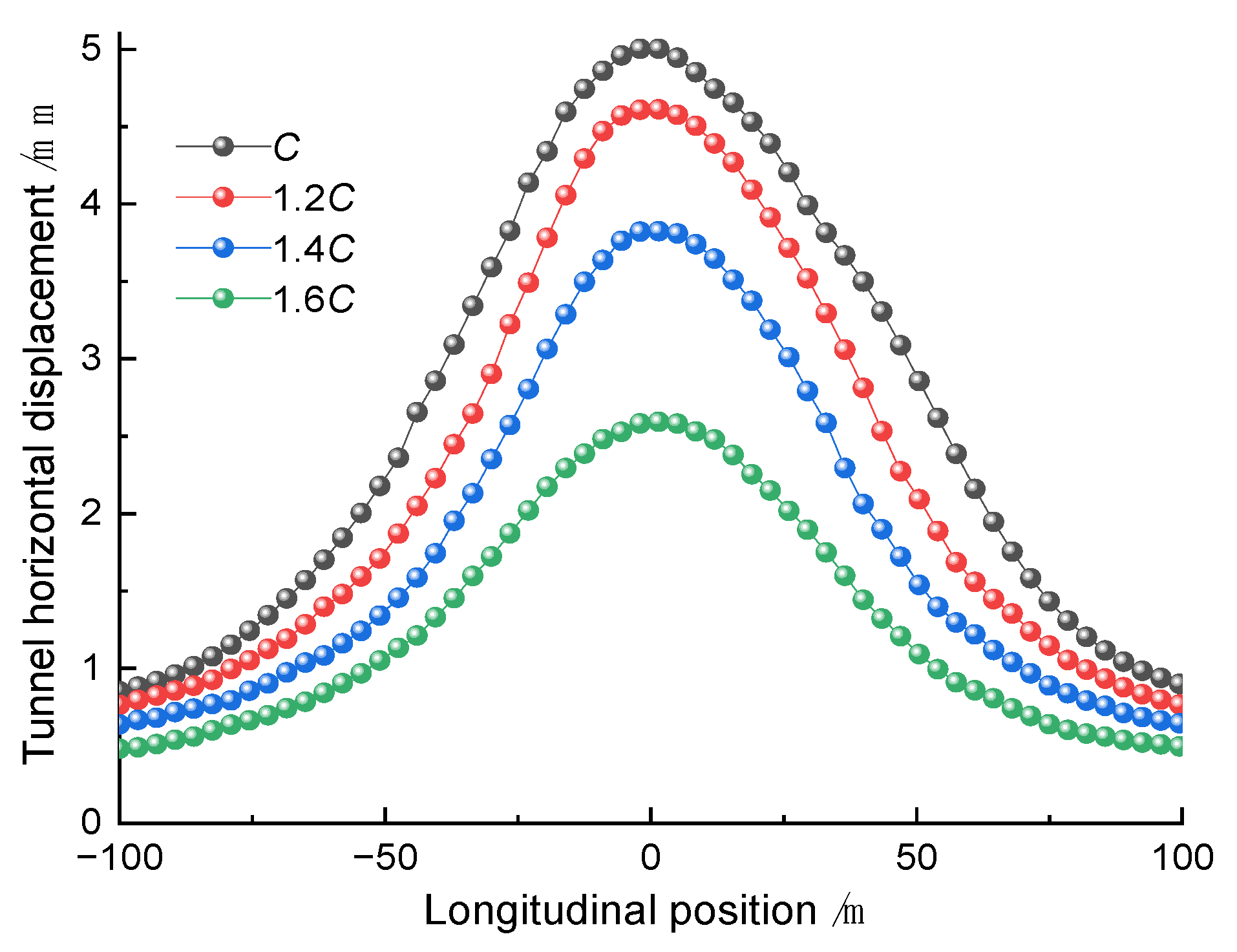
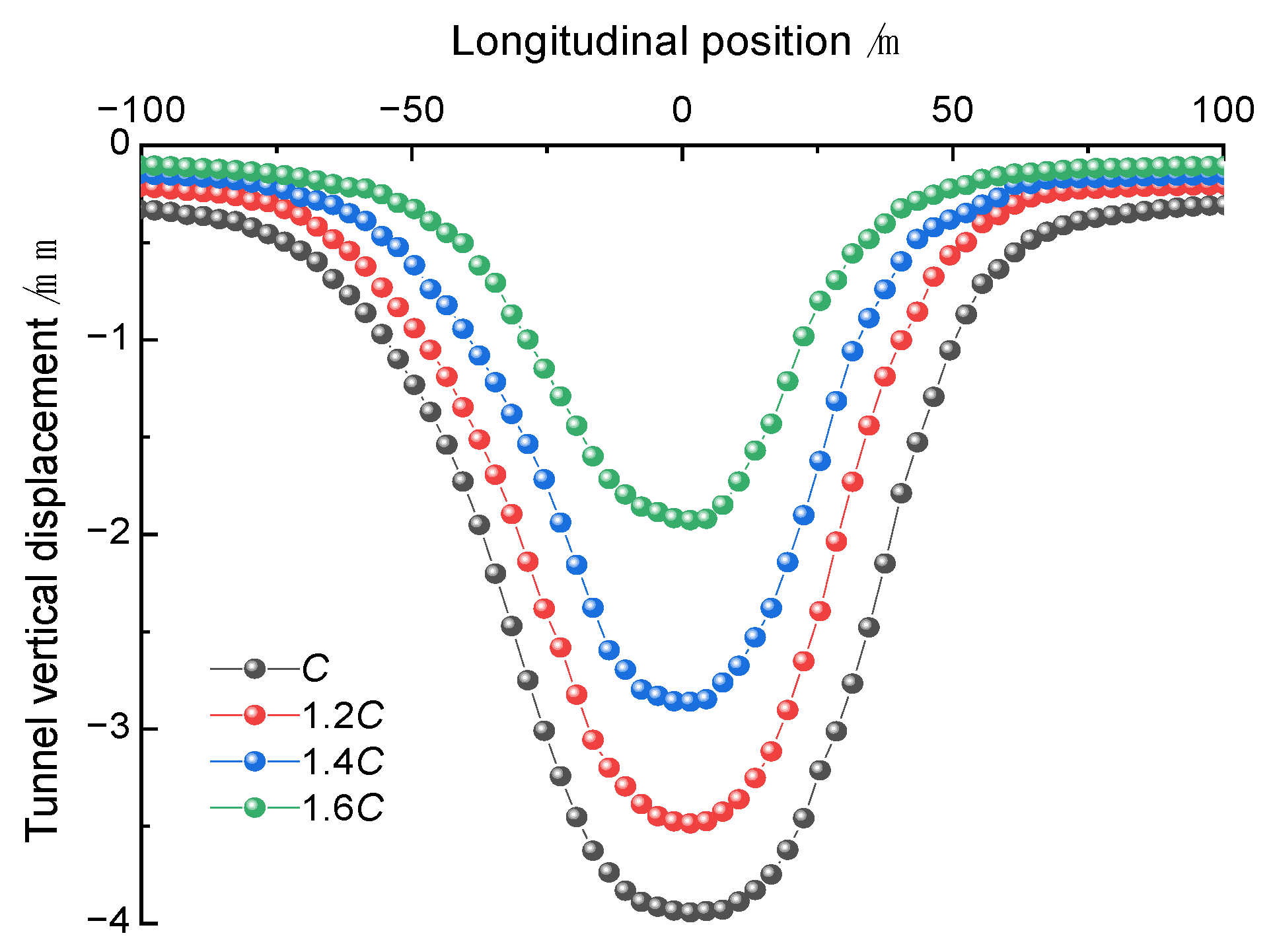





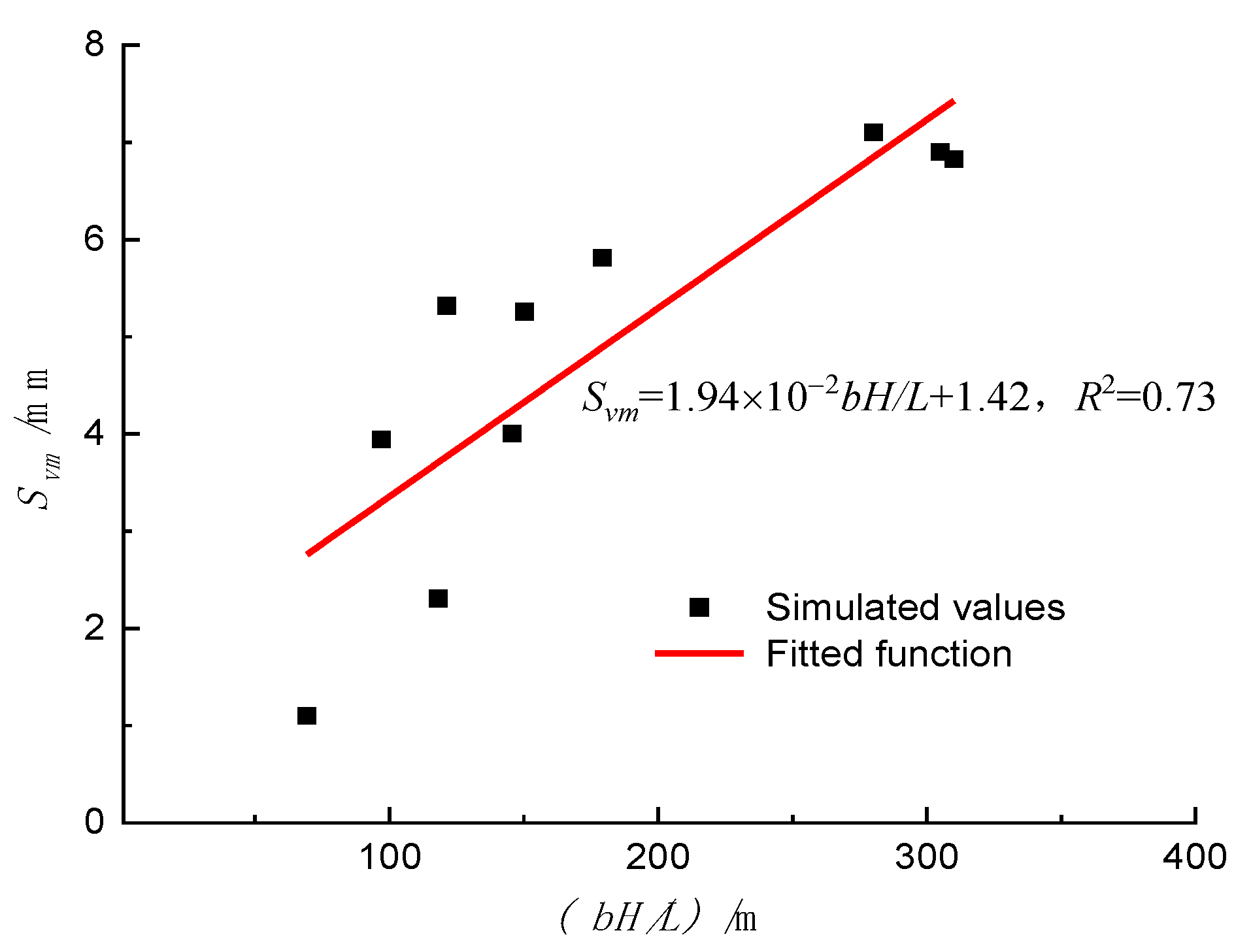
| Stratigraphic (Genetic) | Natural Weight (kN/m3) | Tri-Axial Test Secant Modulus/MPa | Secant Modulus of Elasticity/MPa | Unloading Modulus of Elasticity/MPa | Poisson’s Ratio | Cohesion (kPa) | Internal Friction Angle (°) | Permeability Coefficient (m/d) |
|---|---|---|---|---|---|---|---|---|
| Undisturbed soil | 19.0 | 2 | 2 | 6 | 0.35 | 14 | 15 | 5 |
| Soil clay | 18.5 | 2.8 | 2.8 | 8.4 | 0.33 | 25 | 18 | 0.1 |
| Angular gravel | 19.5 | 6 | 6 | 18 | 0.28 | 0 | 36 | 25 |
| Sandy clay | 21.0 | 8 | 8 | 24 | 0.26 | 25 | 22 | 5 |
| Fully weathered mixed rock | 20.0 | 16 | 16 | 48 | 0.24 | 23 | 28 | 0.1 |
| Intensely weathered mixed rock | 20.5 | 25 | 25 | 75 | 0.23 | 20 | 32 | 0.5 |
| Moderately weathered mixed rock | 21.0 | 70 | 70 | 210 | 0.22 | 200 | 50 | 0.5 |
| Name | Material | Section Dimensions/mm | Unit Weight /(kg/m3) | Elastic Modulus/ GPa | Internal Friction Angle/(°) | Poisson’s Ratio |
|---|---|---|---|---|---|---|
| Retaining pile (Diaphragm wall) | C30 | Thickness 880 | 2400 | 30 | 26 | 0.2 |
| Column pile | C30 | Ø1200 | 2400 | 30 | 26 | 0.2 |
| Crown beam | C30 | 1000 × 1200 | 2400 | 30 | 26 | 0.2 |
| Support beam | C30 | 1000 × 1200 | 2400 | 30 | 26 | 0.2 |
| Waist beam | C30 | 1000 × 1200 | 2400 | 30 | 26 | 0.2 |
| Indicators | Vertical Maximum Displacement Sensitivity Factor Svn | Horizontal Maximum Displacement Sensitivity Factor Shn |
|---|---|---|
| Elasticity modulus E | 0.936 | 0.897 |
| Internal friction angle φ | 0.663 | 0.615 |
| Cohesion C | 0.323 | 0.584 |
Disclaimer/Publisher’s Note: The statements, opinions and data contained in all publications are solely those of the individual author(s) and contributor(s) and not of MDPI and/or the editor(s). MDPI and/or the editor(s) disclaim responsibility for any injury to people or property resulting from any ideas, methods, instructions or products referred to in the content. |
© 2023 by the authors. Licensee MDPI, Basel, Switzerland. This article is an open access article distributed under the terms and conditions of the Creative Commons Attribution (CC BY) license (https://creativecommons.org/licenses/by/4.0/).
Share and Cite
Niu, Y.; Wang, Q.; Ma, F. Study on the Influence of Foundation Pit Excavation on the Deformation of Adjacent Subway Tunnel in the Affected Area of Fault Zones. Sustainability 2023, 15, 9462. https://doi.org/10.3390/su15129462
Niu Y, Wang Q, Ma F. Study on the Influence of Foundation Pit Excavation on the Deformation of Adjacent Subway Tunnel in the Affected Area of Fault Zones. Sustainability. 2023; 15(12):9462. https://doi.org/10.3390/su15129462
Chicago/Turabian StyleNiu, Yungang, Qiongyi Wang, and Fenghai Ma. 2023. "Study on the Influence of Foundation Pit Excavation on the Deformation of Adjacent Subway Tunnel in the Affected Area of Fault Zones" Sustainability 15, no. 12: 9462. https://doi.org/10.3390/su15129462
APA StyleNiu, Y., Wang, Q., & Ma, F. (2023). Study on the Influence of Foundation Pit Excavation on the Deformation of Adjacent Subway Tunnel in the Affected Area of Fault Zones. Sustainability, 15(12), 9462. https://doi.org/10.3390/su15129462





